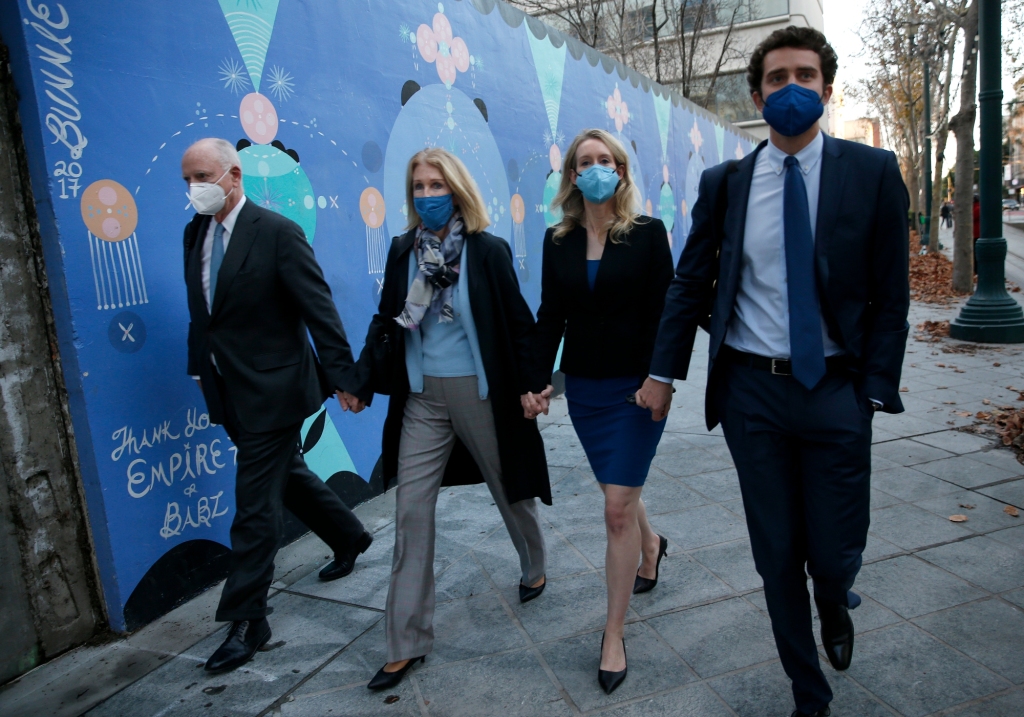SAN JOSE — The criminal fraud trial of Theranos founder Elizabeth Holmes hurtled toward its end Thursday as the largest crowd yet of media and spectators watched attorneys from both sides try to persuade jurors to see the case their way.
Over 14 weeks — and through 32 witnesses — the proceedings have provided a long-awaited window into the spectacular undoing of a Silicon Valley startup that racked up hundreds of millions of dollars in investments, drew dignitaries such as former U.S. secretaries of state Henry Kissinger and the late George Shultz to its board, and made its charismatic young founder an icon until the enterprise imploded.
“She chose to be dishonest with her investors and with patients,” prosecutor Jeff Schenk told the jury during his three-hour closing argument. “That choice was not only callous, it was criminal. Theranos was a house of cards.”

In the eyes of the prosecution, Holmes failed to tell the truth about Theranos’ flawed technology, instead deceiving investors, partners, patients and even her own employees. But her attorneys argue that failing is not a crime, and that Holmes herself was a victim.
In meticulous and repetitive detail, Schenk marched through the testimony jurors had heard from Theranos’ alleged victims and company insiders. Schenk displayed again emails and text messages he said were evidence of Holmes’ deceptions.
The stakes are high for the prosecution, after Holmes dramatically took the stand to testify as her own chief witness and claimed her ex-lover and Theranos’ former chief operating officer, Sunny Balwani, had controlled her in life and work, including forcing her to have sex. Her decision to testify was risky, but legal experts said the emotional appeal could pay off.
Schenk, however, suggested jurors should take Holmes’ testimony in her own defense with a large quantity of salt. “There is no witness who testified in this case who has more bias … than the defendant,” he said.

Although Balwani is to be tried separately next year, Schenk, in trying to refute Holmes’ defense, focused on the two fraud conspiracy charges they both face. “Ms. Holmes’ role is to recruit investors by making false statements,” Schenk alleged, adding that Balwani ran the lab, and “investors would view it as a sort of proof of concept.” Holmes and Balwani “did each other’s jobs at times,” he said.
Schenk also sought to make it clear to the jury that Holmes could be both a victim of abuse and a fraudster. “If you return a verdict of guilty, you are not saying, ‘We the jury do not believe Ms. Holmes’ claims of abuse.’ You do not need to decide whether that abuse happened. The case is about false statements made to investors and false statements made to patients.”
Holmes, who founded the Palo Alto blood-testing startup at age 19 in 2003, is charged with bilking investors out of hundreds of millions of dollars and defrauding patients with false claims that the company’s machines could conduct a full range of tests using just a few drops of blood, when she knew the technology had serious accuracy problems. She and Balwani have denied the allegations.

According to Schenk, Holmes’ allegedly false statements were numerous: that Theranos machines could conduct a full range of tests on blood from a finger-stick; that the testing was accurate, reliable and fast; that the company was financially healthy; that its product demonstrations to investors were legitimate; that Theranos had a positive relationship with business partner Walgreens; that Theranos devices were in military use; that Theranos was not using other companies’ machines; and that major pharmaceutical companies had validated the technology.
Holmes’ statements to investors about military use of Theranos analyzers “were not just false, they were knowingly false,” Schenk said. And she not only applied stolen pharmaceutical company logos to glowing internal Theranos reports, she sent them to Walgreens with a comment saying the reports were “independent” and “from” the companies, according to an email shown to jurors.
Although Holmes was repeatedly informed of problems with testing and test results, patients were led to believe that Theranos could “still test blood accurately and reliably,” Schenk said.
When it was his turn, Holmes lawyer Kevin Downey adopted a tone of outrage from the start, telling the jury that prosecutors had left out crucial information that did not support their allegations.

Downey emphasized to jurors that if they find Holmes guilty, they must believe beyond a reasonable doubt that she intended “to defraud someone of money or property by means of deception.”
“If somebody is acting in good faith, you have no reason to find them guilty,” Downey said.
Downey focused heavily on the logo issue, telling the jury not only that Theranos had completed 11 projects with pharmaceutical companies, but that the companies whose logos were put on Theranos reports had not objected. He did not mention that representatives from both companies, Pfizer and Schering-Plough, testified earlier that they had dismissed Theranos’ technology and found Holmes evasive.
Holmes’ pursuit of FDA approval for her technology, in 2013 and afterward, showed her good intentions, Downey argued.
“They thought they had invented a technology with massive capacity, and Ms. Holmes was telling the world about that,” Downey said.

Her statements about Theranos’ technology were based on the firm’s 4.0 device, he said, which was never used for clinical testing — even though all 50,000-plus patient test results from the commercially-used device, “Edison 3.0,” were voided by a lab director who believed they were unreliable. Downey said that when Holmes talked about the company’s technology, she was talking about the 4.0 device.
And when a federal regulator found life-threatening deficiencies in Theranos’ lab testing, Downey added, Holmes brought on a team of experts to address problems and sought outside review.
“It’s hard to see how someone acting with bad intent would undertake those steps,” he said.
Legal analyst Michele Hagan, who has attended the trial regularly, said the prosecution effectively summarized their case. “We know now it’s a case about real people who lost money and patients who were given false results.”
Holmes’ defense, Hagan added, appears to be “rolling the dice” with a focus on persuading the jury that she acted in good faith. “The problem is, that’s not consistent if you think she made any misrepresentations … that she lied about any of this stuff,” Hagan said.
Holmes, charged with 11 felony fraud counts, faces years in prison and fines, plus possible restitution, the Department of Justice has said. Her defense continues its closing arguments Friday.











